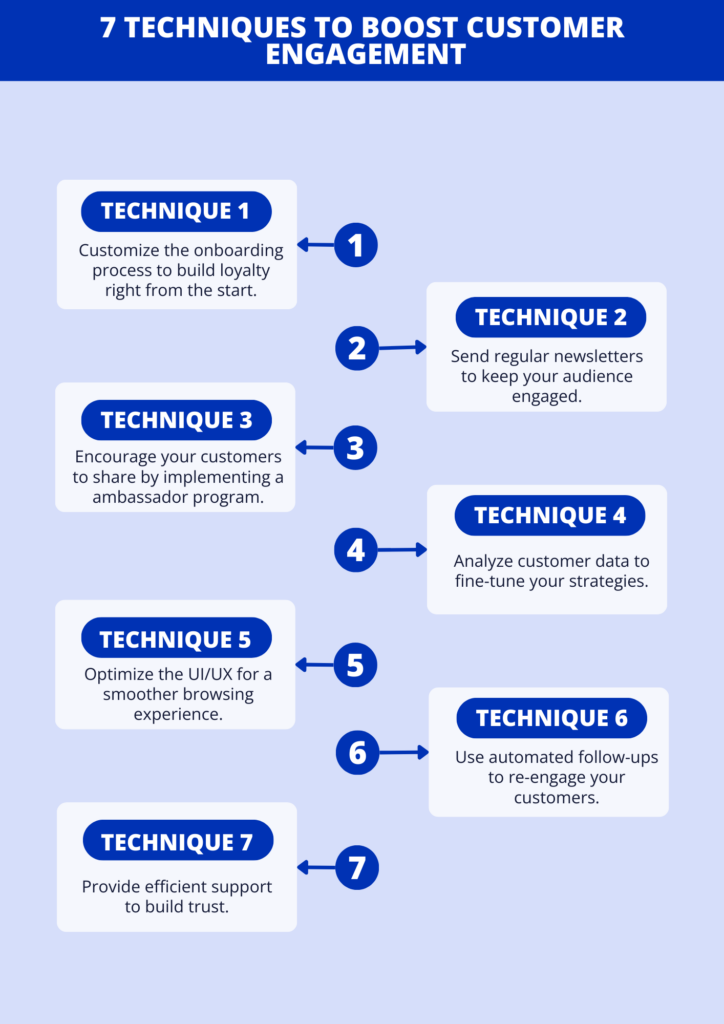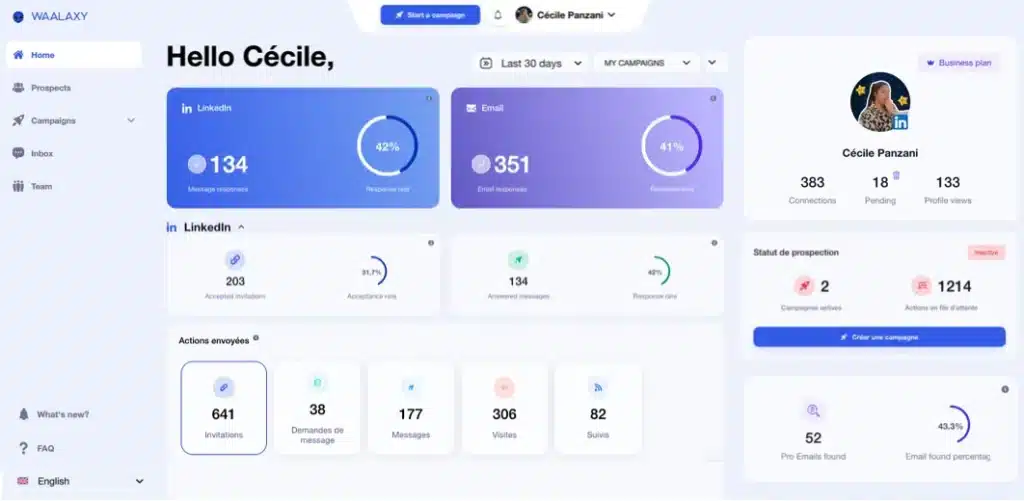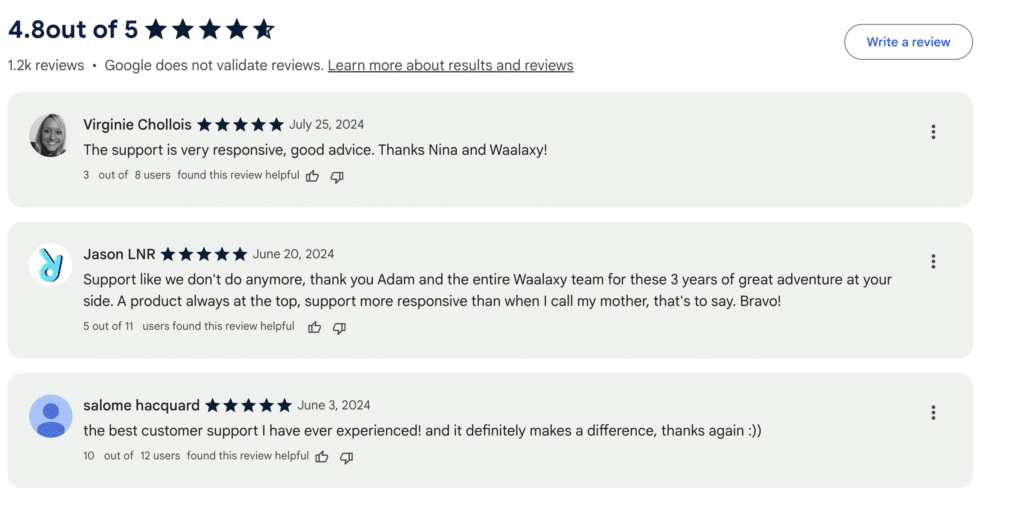Looking to enhance customer engagement? You’re in the right place! 💡
Customer engagement is the driving force that powers your business. The more engaged your customers are, the more loyal they become, the more they spend, and the more they spread the word about your brand. It’s essential for building strong, enduring relationships.
Ready to discover how to take your customer engagement to the next level? 🚀 Let’s dive in!
Measuring customer engagement: why and how?
Definition of customer engagement
Customer engagement goes beyond just getting a “like” on your Instagram or Facebook posts. It’s about how customers interact with your brand, and it begins well before they make a purchase. It encompasses their loyalty, trust, satisfaction, and the emotional connection they feel toward your brand. ✨
Why measure customer engagement?
You’ve probably heard the saying, “What gets measured gets improved.” And it’s true! If you don’t know where your customer engagement stands, how can you tell if you’re on the right path?
Measuring customer engagement lets you see if your strategy is effective, if your customers are satisfied, and most importantly, it gives you the insights needed to make adjustments if necessary. 💚
Here’s why it matters so much:
- Build customer loyalty: An engaged customer is a returning customer. And as we all know, retaining an existing buyer is much more cost-effective than acquiring a new one. By measuring engagement, you can identify early signs of disinterest and take action before it’s too late. ✨
Did you know? It costs up to 7 times more to win over a new customer than to retain an existing one. What’s more, a loyal buyer spends on average 2.5 times more than a new one. 👀
- Improve your ROI (return on investment): The more engaged your customers are, the more likely they are to spend with you. By tracking their engagement, you can ensure that every dollar spent on your marketing campaigns delivers maximum value. 💸
- Reduce customer retention costs: By understanding what resonates with your customers, you can reduce the effort (and cost) required to keep them engaged. For instance, by sending personalized recommendations based on their previous purchases, you demonstrate that you truly understand their needs, all while saving on less targeted marketing campaigns. 🎯
- Increase customer satisfaction: A satisfied customer is a loyal buyer—someone who speaks highly of your brand, returns for more, and recommends your products to others. By measuring engagement, you can identify what’s working and what needs improvement, allowing you to enhance the overall customer experience.✨
- Better understand your customers’ needs: Engagement is also a treasure trove of information. What captures your customers’ attention? What keeps them coming back? By measuring their engagement, you gain valuable insights into their preferences, enabling you to serve them better. This allows you to continually improve your marketing funnel.😉
- Reinforce brand image: The more engaged your customers are, the more emotionally connected they become to your brand. This not only strengthens their loyalty but also enhances your brand’s perception among their peers. For example, by encouraging them to leave positive online reviews, you boost your reputation while deepening their connection to your brand. 🌟
Measuring customer engagement is like having a compass. It guides you, helping you stay on course and steer clear of potential challenges, all while maintaining a loyal and satisfied customer base. 😌
How do you measure customer engagement?
To understand and enhance customer engagement, it’s crucial to track specific key performance indicators (KPIs). These metrics provide a clear view of the relationship your customers have with your brand, empowering you to take informed action.
1. Retention rate
The retention rate measures the percentage of customers who continue to use your products or services over a specific period. A high retention rate indicates that your customers are not only satisfied with what you offer but are also deeply attached to your brand, choosing to stay loyal. This suggests they find genuine value in your services, which strengthens their commitment. ❤️
Here’s how it’s calculated : Retention rate=[(Number of customers at the end of the period – New customers)/Number of customers at the beginning of the period] X 100.
Example :
– Number of customers at start of period: 1,000.
– Number of new customers during the period: 200 customers.
– Number of customers at end of period: 1,100.
Step 1: Calculate the number of remaining customers
Number of customers at end of period – New customers = 1100 – 200 = 900
Step 2: Apply the formula
[(900)/Number of customers at start of period] X 100. = ( 900 / 1000 ) × 100 = 90%.
This means that 90% of your initial customers have continued to use your services during this period 🥳
The 3 benefits of having a good retention rate are:
- Reducing the cost of acquiring new customers 💰
- Creation of a solid base of loyal customers 😉
- Generate recurring revenues. 💶
2. Email open and click rates
Open and click rates are key indicators of your customers’ interest in your e-mails. A good open rate means that your subject is attention-grabbing, while a good click rate indicates that the content is actionable.
🚨 If the latter are low, it’s a warning signal: perhaps your subject lines aren’t catchy enough, or your e-mails aren’t targeted enough. What can you do? Here are a few tips:
- Revise your email subjects: Make them catchier, ask questions, or change your copywriting.✍🏼
- Segment your list better: Make sure each subscriber receives emails that match their interests. A personalized message is always more engaging.🎯
- Test sending frequency: If you send too many emails, you risk tiring your subscribers. Try reducing the frequency to see if this improves engagement.📆
A good open rate typically ranges from 14.5% to 29.7%, though it can vary depending on the goal of your email campaign (transactional, informational, etc.). As for the click-through rate, it should fall between 2% and 5%. If your metrics align with these figures, congratulations! That means you’re successfully capturing your subscribers’ attention. 🎉
3. Net Promoter Score (NPS)
Net Promoter Score is a crucial metric that gauges how likely your customers are to recommend your company to others. By asking a simple question, “On a scale of 0 to 10, how likely are you to recommend our company?” you can categorize respondents into three groups:
- Promoters (9-10): Those who actively recommend your brand.
- Passives (7-8): Satisfied, but not particularly enthusiastic.
- Detractors (0-6) : Dissatisfied, they can damage your reputation.
Calculation : NPS : % of promoters – % of detractors
Example:
You survey 100 customers.
– 60 customers give you a score of 9 or 10 (Promoters).
– 20 customers give you a score of 7 or 8 (Passives).
– 20 customers give you a rating between 0 and 6 (Detractors).
In this example :
– % Promoters = 60%.
– % detractors = 20%.
So your NPS would be :
NPS =60%−20% =40.
An NPS of 40 is a good sign. 🚀
A high NPS, meaning above 30, indicates strong brand loyalty, which is crucial for growth and reducing customer acquisition costs. Typically, large companies score around 50. The NPS helps you identify areas for improvement to turn detractors into promoters. 🚀
4. Interaction on social networks
Interactions on social networks, such as likes, shares, and comments, are vital indicators of audience engagement. The more your followers interact with your content, the more connected they are to your brand. If your posts generate a lot of reactions, it means your message is resonating! 🤩
The calculation: (Total interactions (likes, shares, comments) / Total number of followers) X 100
Example:
Let’s say you have 10,000 followers on Instagram. You publish a post that receives:
– 500 likes.
– 100 comments.
– 50 shares.
Total interactions = 500 likes + 100 comments + 50 shares= 650
(650 / 10 000) X 100
6,5%
An engagement rate of 6.5%? That’s great! 🎉
A good engagement rate on social networks is around 3%, , though it varies depending on the platform:
- 📸 Instagram: between 2% and 3%.
- 📱 Facebook: between 1% and 5%.
- 🐥 Twitter: between 0.5% and 1%.
- 💼 LinkedIn: between 2% and 6%.
Having a high one allows you to :
- Strengthen your community : An engaged audience is a loyal one. Regular interactions deepen the connection between your brand and your followers. 💯
- Get more visibility : The more reactions your posts generate, the more social media algorithms promote them, enhancing your organic reach.📸
- Adjust strategy: By monitoring engagement, you can identify what’s working and what needs improvement. This enables you to tailor your content to better meet your audience’s expectations.✅
5. Customer satisfaction score (CSAT)
CSAT is typically measured by asking customers to respond to a straightforward question, such as: “On a scale of 1 to 5 (or 1 to 10), how satisfied are you?” The responses are then aggregated to calculate an average satisfaction score.
Calculation: (Number of positive responses / Total number of responses) X 100
Example:
you sent a CSAT survey to 200 customers after a purchase. Here are the results:
– 120 customers gave a score of 5.
– 50 customers gave a score of 4.
– 20 customers gave a score of 3.
– 10 customers gave a rating of 2 or 1.
Calculation of positive responses :
120 + 50 = 170
Calculation of CSAT :
CSAT=(200170)×100=85%
A CSAT of 85% indicates that the vast majority of your customers are happy. 😌
A CSAT below 50% is a red flag! You need to act quickly to address the issues highlighted by your customers. 🏃🏻♀️
6. Website behavior analysis
There’s more to your strategy than just numbers. Observing how visitors interact with your website is like getting a glimpse into their minds. It helps you understand what captures their attention, what prompts them to leave the page, and what encourages them to click on a call-to-action.
Tools like Hotjar and Google Analytics can assist you with this. They provide insights into where visitors click, how long they stay on each page, and even how far they scroll.
You can also use heatmaps! 🔥 These maps give you an instant visual of the “hottest” areas on your site—places where visitors spend the most time and click the most.
Example: Thanks to a heatmap analysis, you notice that most of your visitors spend a significant amount of time on your customer testimonials page before moving on to the contact page. 💬
What does this tell you? Testimonials play a crucial role in your audience’s decision to reach out. You might consider showcasing them even more prominently, perhaps directly on your home page or a landing page. 👀
Analyzing these behaviors enables you to optimize the user experience. If you see a lot of visitors leaving a page quickly, it might indicate that the content is unclear or the navigation is too complicated. By making adjustments, you can retain more visitors and potentially increase conversions. 💰
7. Direct feedback
Reviews, complaints, and other forms of customer feedback are crucial for understanding customer engagement. They reveal what customers truly think about your offerings. This feedback helps you identify what’s working well and what needs improvement. 🥸
➡️ How do I use this feedback?
- Improve your service: If multiple customers raise the same issue, it’s a clear indication that something needs fixing. For instance, if they frequently mention problems with your contact form, it’s an opportunity to simplify and improve it.👀
- Reinforce customer satisfaction: Responding quickly to complaints can transform a negative experience into a positive one. It shows that you’re attentive and care about their concerns. 👂🏻
- Identify strengths: Positive reviews highlight what your customers love about your offerings. By showcasing these strengths on your website or social media, you can attract even more potential customers. 🙌🏻
Encourage your customers to share their opinions regularly. The more you listen, the better you can adjust your offerings to meet their expectations, boosting their satisfaction and loyalty.
Tips: Send them an e-mail a few days after their orders or services encouraging them to put in a positive review! ⭐️
8. Loyalty programs
Loyalty programs are a great way to reward your customers for their long-term loyalty, while increasing their customer engagement with your brand.🥰
Loyalty programs also enhance customers’ sense of belonging to a community. When they feel they’re receiving unique privileges, they’re more likely to stay loyal to your brand over the long term. ⏳
➡️ Here are some reward ideas that work:
- Accumulated points: With every purchase, customers earn points that can be redeemed for services or discounts. The more they buy, the more they are rewarded. 🧠
- Exclusives: Offering special discounts exclusively for loyalty program members can encourage them to shop more frequently. 😎
- Special offers: Create promotions or events just for your loyal customers, such as private sales or early access to pre-orders. 🎁
Example:
Zoom launched Zoom Community, a premium user group that encourages experience sharing and peer interactions directly on the platform. 🎯 Members can unlock statuses and badges based on their engagement, and the most active users get special recognition. 🌟
This private community strengthens the sense of belonging by building a network of loyal ambassadors, while fostering valuable conversations around Zoom’s products. With this approach, Zoom boosts both user loyalty and engagement. 🔥
7 Techniques to improve your customer engagement
Customer engagement is crucial for any company aiming to not only attract but also retain its customers. To enhance this engagement, three pillars are essential: people, platform, and processes. These components work together to create an exceptional customer experience. To illustrate these techniques, let’s look at the example of Waalaxy.👽

1. Onboarding
The first contact with a new customer is like a first date: it’s where everything matters! Successful customer onboarding is crucial for building strong customer engagement from the very beginning. It’s the moment when you demonstrate to your new users that they made the right choice in choosing your brand.🥰
At Waalaxy, we’ve implemented several strategies to ensure our onboarding process is just right!
1) Live demos: There’s no better way to quickly grasp how to use a platform. Our live demonstrations allow new users to see the power of Waalaxy in action, with the opportunity to ask questions in real time. It’s interactive and dynamic, and we offer them regularly. 📹
2) Support: Using a new tool for the first time can be a bit intimidating. At Waalaxy, we guide each user step by step through their initial experience to ensure they feel confident and supported. 🙌🏻
3) Emailing: We don’t leave our new users on their own after they sign up. A series of emails helps them navigate the first steps, offering practical advice, tips for optimizing Waalaxy, and additional resources. 😎
We provide ongoing support through our blog and YouTube channel, offering users valuable content to help them get the most out of Waalaxy over time.
2. The newsletter
Regular communication is essential to keep your customers interested. Whether it’s about your company or industry news. Waalaxy has adapted its newsletter accordingly, creating not one, but two distinct newsletters: 👇🏻
- For platform users: his newsletter is specifically designed for current Waalaxy users. It provides updates on new features, tips for optimizing the use of the extension, and more. The goal is to help users get the most out of our tool.✨
- “Supernova“: Waalaxy goes beyond just addressing its users by creating “Supernova,” a newsletter aimed at anyone interested in prospecting and marketing. It offers practical resources and covers a variety of themes, appealing not only to current users but also to a broader audience interested in these topics. This approach positions Waalaxy as an expert in its field while expanding its customer base. Impressively, this newsletter boasts an open rate of over 40%! 🎉
3. Ambassador program
What better way to promote your brand than with satisfied customers? Waalaxy launched an ambassador program that encourages customers to spread the word about the brand in exchange for financial compensation. This program not only boosted engagement but also attracted new customers through word-of-mouth. 🚀
The best part? The program is open to everyone, allowing any user to join this community. 😎
To ensure the success of this program, we have implemented:
- An emailing: Each ambassador receives regular emails to keep them updated on program news, offer tips for recruiting affiliates, and more. These emails help maintain engagement and provide valuable tools and advice to help ambassadors succeed. 🏆
- A dedicated platform: This platform allows brand ambassadors to track their progress, manage their list of affiliates, and easily share the brand. With this platform, ambassadors feel well-supported and empowered to effectively promote Waalaxy. 👇🏻

- To strengthen the sense of belonging, Waalaxy organizes exclusive events for its ambassadors, such as competitions and challenges. These events foster community spirit and encourage friendly competition, making the ambassador experience even more engaging. 💪🏻
4. Data analysis
Knowing your customers is key to serving them better and building a strong, lasting relationship. Analyzing customer data is crucial for personalizing every interaction. By understanding your users’ behaviors and preferences, you can tailor your offerings to boost customer engagement. 🙌🏻
Here’s how we do it at Waalaxy:
- Data Collection: We use analytics tools to gather insights into our users’ behavior. This includes tracking everything from the most-visited pages and subscription types to identifying the areas where users are most engaged. 🥰
- Adapting the Offering: By gaining a deeper understanding of what our customers want, we regularly adjust our offerings to meet their expectations, such as by adding new features that address their needs. ⚙️
To keep track of all our new features and enhancements, you can find our roadmap right HERE !
5. Enhanced UX/UI
UI/UX design is crucial for maintaining and enhancing customer engagement. When your customers find your site or app pleasant and easy to use, they are more likely to stay and engage. 👀
At Waalaxy, we take this very seriously. Our goal? To offer our users the simplest, most fluid tool possible. Here’s how we achieve this:
- Ease of use: We designed an intuitive platform that’s accessible even for beginners. Every aspect is crafted so that users can navigate effortlessly, find what they need quickly, and accomplish their goals with ease. 💪🏻
- International reach: To enhance the user experience globally, we’ve translated our extension into more than 10 languages. This ensures that users from different regions feel comfortable and supported while using our tool. 🌍
- Design: A modern, clean design makes the user experience even more enjoyable. At Waalaxy, we’ve opted for a sleek look where every element is thoughtfully placed. There are no unnecessary elements; everything—from prospects to campaigns, results, and resources—is just a click away. ✨

6. Automated follow-ups on LinkedIn
Don’t let your prospects slip away! It’s essential to stay in touch with those who have shown interest but haven’t yet taken the plunge. You can do this through automated remarketing.🤓
But how? Simply use Waalaxy. It allows you to manage and segment your prospect lists, send personalized email and LinkedIn campaigns, and analyze your results in no time. 😉
➡️This way, you’ll:
- Save time: No more manual tracking of each prospect. Waalaxy handles everything, freeing you up to focus on other aspects of your business. ⏳
- Personalize at scale: Even though messages are sent automatically, they remain personalized through variables, giving the impression of a direct exchange with your target audience. 🎯
- Continuously optimize: With the data you collect, you can refine your campaigns over time, adjusting your segments and messages for better results. 💌
Example of an e-mail
Subject : You’re so close! Finalize your purchase with a little surprise 🎁
Hello {{firstName}},
We noticed you had a few nuggets waiting for you in your basket! They’re still there, ready to join you. 🎉
Here’s what you left behind:
[List of items in basket with images and prices]
To thank you for your interest, we’re offering you [X%] off if you finalize your order within the next 24 hours! 🚀
👉 Complete your purchase now: [Link to basket]
Thank you for your confidence,
The [Name of your company] team
7. Customer support
Good customer support is a crucial pillar of engagement. When customers know they can rely on you when they need assistance, it fosters trust and loyalty toward your brand. At Waalaxy, we understand this! That’s why we’ve developed responsive customer support, enhanced by the efficiency of a chatbot.🧨
Waalaxy’s strategy:
- Chatbot for efficiency: Our chatbot handles basic requests and simple procedures, such as “How to choose the right sequence?” This allows us to resolve the majority of inquiries quickly without needing to involve human resources for every request. 🤖
- Human assistance : For more complex issues or when a customer needs special attention, our support team steps in. This hybrid approach ensures that each customer receives a response tailored to their specific situation. ☎️
The result? Customers feel heard and supported, even when something goes wrong. 🌈 Support like this can transform a negative experience into a positive, long-lasting relationship. Here’s the proof: 👇🏻

How about a recap?
Customer engagement is a critical driver of your company’s growth. By focusing on three key pillars—people (customer support, newsletter, ambassador program), platform (UI/UX), and processes (onboarding, automatic follow-up)—you can transform occasional customers into loyal ambassadors. Remember, every interaction matters. 🚀
Frequently asked questions
What are the differences between engagement, satisfaction and customer experience?
These three terms are often used together, but they don’t mean exactly the same thing. Here’s a little deciphering:
- Customer experience: This refers to all the interactions a customer has with your brand, from the first ad they see to the after-sales service they receive. 🙌🏻
Example : If you order sneakers online, the customer experience includes site navigation, ease of payment, speed of delivery, and even the ability to return the shoes if they don’t fit.
- Customer satisfaction: This is how the customer feels after an exchange with your brand. Are they happy or not? For example, does the product perfectly match your customer’s expectations? How did he find customer service? 🥸
- Customer engagement: This is when the customer isn’t just satisfied, but starts actively interacting with your brand. They follow you on social networks, take part in your events, share their opinion, and above all, they come back to buy from you. 👀
What are the 4 levels of customer engagement?
Customer engagement can be considered a progression through four levels, each representing a degree of involvement for the customer. 👇🏻
- Discovery (First Experience): This is the initial contact between the customer and your brand. At this stage, the customer is just getting to know you. For example, they might see an ad on Instagram, click on the link, and view your landing page. Engagement is typically low at this point.
- Building the Relationship: Now that the customer is familiar with your brand, they begin to interact more. They might subscribe to your newsletter, follow you on social media, or even make their first purchase. Engagement is growing at this stage. 👷🏻♀️
- Loyalty: At this point, the customer is convinced of your brand’s value and starts returning regularly. They make repeat purchases, recommend your brand to friends, and might even join a loyalty program. 😎
- Advocacy: This is the ultimate level of engagement! Here, customers go beyond loyalty and become ambassadors for your brand. They leave reviews, share your posts, and actively recommend your brand to others. 👂🏻
Customer engagement no longer holds any secrets for you! 🚀









